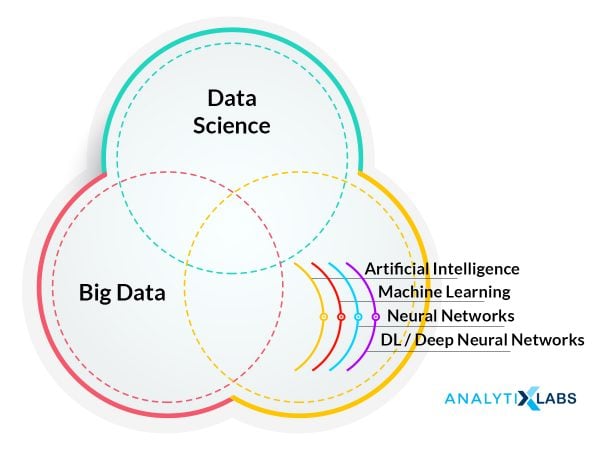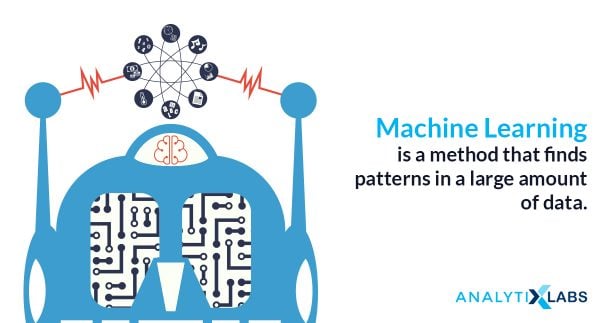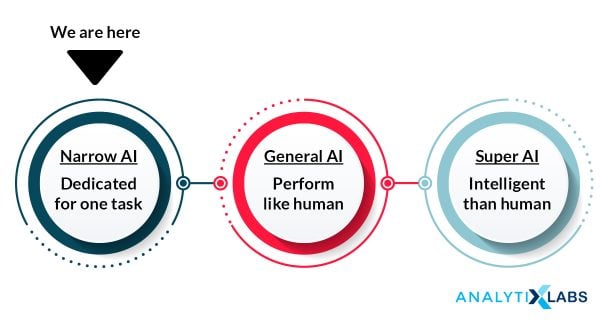The existence of AI has instilled the fear of dystopia in most of us. But that’s just fiction, where we have seen AI making human-killing machines or becoming potential lovers.
So, the obvious query here would be – what is the goal of artificial intelligence currently? You can call AI, the secret recipe that renders a design, mimicking human operation. AI has become the pivotal lynchpin in today’s digitized transformation.
Although the definition of AI has transformed over time, at its core it has always been about machines that can think like humans – plan, reason, learn, solve problems, represent knowledge, show motion, perception and be socially receptive. Apart from its general goal, AI research is aiming to achieve social and creative intelligence to further AI’s influence.
Several recognized breakthroughs in the field of AI can be seen in the field of quantum physics, financial world, computer technology et al. AI has become the driving force to the fourth industrial revolution.
Segments of AI

The works of AI are split into two branches – Applied AI and Generalized AI. Applied AI deals with the principles of emulating human operation to perform something specific. Generalized Artificial Intelligence deals with machine learning that can help machines perform any task which otherwise requires human intervention.
Ten years ago, people would laugh at the instances of Artificial Intelligence. But with its recent cultural and technological consolidations, some of the terms like Machine Learning, Deep Learning, Neural Networks, Natural Language Processing are becoming popular. Here’s a concise guide to understanding these recurrently used terms.
You may also like to read in detail: What is Applied AI?
Machine Learning (ML)

Machine Learning is an analytics system that collates large chunks of data and locates patterns. Popular platforms such as Netflix, Facebook are known to use Machine Learning. The analytic system helps these platforms find recommendations based on their customer viewing history and other online habits. ML has three forms – supervised, unsupervised, reinforcement learning.
Some of the recurrent applications of AI are seen in supervised learning – for instance, self-driven vacuum cleaners use algorithms and image labeling to avoid a collision. Unsupervised Learning locates patterns to predict future human habits based on the information it collates. Through Reinforced learning, a system infers on results-driven by self-taught tactics via trial and error methods.
Deep Learning
Deep Learning is a subset of AI which helps systems recognize and process large amounts of data. For instance, self driving cars use deep learning to map objects and pedestrians on roads. Deep Learning is closely associated with Neural Networks that use web computation designed to imitate the human brain.
So, a self-driven car learns more with their driving experience. The more it drives, the more likely it is to map humans of various shapes, sizes, and colors. Facial Recognition also uses deep learning that analyzes a human face to find a match via the algorithm to calculate the distance between the facial features.
Natural Language Processing (NLP)
NLP is defined as the automated manipulation of natural languages like text or speech via software. Google Assistant, for example, can understand when you want to reach your friend’s house, showing you the destination.
But how does NLP come into play? NLP uses Machine Learning techniques to assess the meaning of your input by tagging parts of that speed input and recognising the relation between words to produce an output. Google introduced its smart compose feature for Gmail that uses NLP to offer suggestions for a sentence in the mail body.
To understand and be a part of the discussions concerning AI, there has to be some sound knowledge of its basics.
AI can be divided into three broad types depending on the level of intelligence embedded into a system and its functionalities.
You may also like to read: Data Science vs Machine Learning vs AI Deep Learning – What is the difference?
Types of AI

Types of AI Based On Capabilities
Artificial Narrow Intelligence (ANI)
Alternatively known as Weak AI, this type of AI has no self-awareness or intelligence. As you can understand from its name ANI is capable of performing single narrow tasks. It is possessed by a range of narrow abilities. As of now, ANI is the only kind of AI existing for now.
- ANI can’t function beyond the threshold of their capacity.
- They are trained for one specific task
- They can fail if they fall under unpredictable pathways.
- ANI has been implemented in areas like e-commerce, self-driven automobiles, image recognition, and speech recognition.
- NLP used by AI assistants is also used in applications like chatbots. With its recognition techniques via speech and text recognition, NLP helps these programs interact with humans in the most natural way attainable.
- AI systems are also used in the fields of medical diagnosis to enhance accuracy and replicate human-like reasoning and cognition.
- Virtual Assistants like Siri, Cortana, Alexa are some of the prime examples of weak or narrow AI. They combine several weak techniques to do what they are asked of – their output can be quite narrow if/when you are conversing with any of these virtual assistants.
Artificial General Intelligence (AGI)
Also known as strong AI, an AGI integrated system is as smart as a human being. They will be able to perform tasks that otherwise require human intervention.
- AGI is modeled after the human brain to create general intelligence.
- The only deterrent to simulating human-like cognition is the lack of comprehensive knowledge of the human brain.
- The primary idea behind AGI is to outperform human intelligence.
- Researchers are working towards creating AGI powered machines
- There is no known system that exists under general AI which is nearly as perfect as humans.
- AGI is often deemed as a threat to human existence. Stephen Hawking stated that “The development of full artificial intelligence could spell the end of the human race…. It would take off on its own, and re-design itself at an ever-increasing rate. Humans, who are limited by slow biological evolution, couldn’t compete and would be superseded.”
Artificial Super Intelligence (ASI)
Leading AI thinker Nick Bostrom defines ASI as “an intellect that is much smarter than the best human brains in practically every field, including scientific creativity, general wisdom, and social skills.”
- ASI is that stage of AI that will be equipped to surpass human intelligence.
- ASI is currently dwelling as a hypothesis and is often seen in sci-fi movies.
- Hypothetically, ASI will be able to perform things like arts, decision making, and emotional relationships.
- What differentiates humans from machines can soon be a diminishing line.
- Super AI or ASI can outperform cognitive processes that are defined by human norms.
- Some of its key characteristics include autonomous thinking, enhanced reasoning, puzzle-solving, planning, learning, communicating et al.
Types of AI Based On Functionality
Reactive Machines
Reactive Machines solely operate on present data along with their current context.
- These are the most basic AI systems out there currently.
- They don’t store any experience or memories to infer future actions.
- They only act on what happens currently
- Google’s AlphaGo can be a great example of Reactive Machines.
Limited Memory
As the name suggests, Limited Memory AI can make informed choices or improve their decision based on the data stored or recorded in its memory. However, these memories are short-lived.
- These machines can store past experiences or data for a short frame of time.
- They can be used for storing data for a limited frame of time
- Autonomous cars are one of their prime examples that have limited memory systems. These vehicles store the speed of any nearby car, the speed limit, and assess the distance of other vehicles to navigate on the road.
Theory of Mind
Theory of Mind is more advanced where they have been speculated to play a major role in understanding human psychology.
- This type of AI would understand human emotions, beliefs, and will be able to socially interact like humans.
- They haven’t been developed yet but researchers are trying to develop such AI systems.
Self-Awareness
This type of AI indicates that machines will have their consciousness and become self-aware.
- These machines will have enhanced intelligence, consciousness, self-awareness, and sentiments.
- They will be smarter than the average human mind.
- It is a hypothetical concept and is yet to exist.
Related: Components Of Artificial Intelligence – How It Works?
How to Learn AI and How Data Science Factor into the Learning process?
Terms like Data Science, AI, and ML are recurrently used, interchangeably. Often there are some common questions of what is the goal of artificial intelligence or machine learning, or their relation. So, let’s demystify them and understand how they are related to one another and their use. Data Science is a field that deals with the extraction of insights from collected data. This field merges with other fields of computer science and statistics for an interdisciplinary approach.
The interdisciplinary field of data science uses a wide array of fields like machine learning, AI, statistics, et al. The basic premise behind this field is to develop an algorithm that receives input and leverages its predictive model to predict an output. So, the process involves predictive modeling and data mining.
For a simpler view in understanding the relationship between these technologies, refer to the image below. So, AI is based on ML where ML is part of data science that draws features like algorithms and statistics to assess extracted data from multiple sources.
Now, data science merges algorithms that are obtained from ML to find a solution. So, one can ideally say that data science is an all-inclusive or an umbrella term consisting of aspects of ML, which also is a part of AI. ML and AI are thus part of data science.
You may also like to read: How To Learn Artificial Intelligence? Get Started with AI
By the looks of it, if one needs to invest in Data Science to learn AI. According to a survey conducted by Gartner’s 2019 CIO Agenda, organizations jumping to adopt AI have jumped from 4% to 14% between 2018 & 2019. Another study conducted by Indeed.com suggests that job posting for AI and data scientists have risen to 29% between 2018 and 2019.
If you want to chart a career path and learn AI and ML, the ideal option is to start with data science. They also have to have a working knowledge of programming languages like Python, R, and SAS. Any accredited data science program will enable a comprehensive training in the fields of AI and ML. An industry relevant AI course should cover Data Science & Machine Learning for beginners to gain professional level competency.
Scope of AI In Our Daily Lives
“AI is the science and engineering of making intelligent machines, especially intelligent computer programs.” – Alan Turing
Although there has been the development of paranoia and fear amongst experts, the friction has not deterred any advancement in the field of AI. Although several tech giants like Facebook, Amazon, Microsoft, and Google have shown initiative to advocate ethical AI implementations.
That being said, AI has already started to become an inseparable part of our daily lives. ANI, for instance, has been implemented in-car systems for anti-lock brakes or to trigger autopilot. AI is also the driving force behind music services like Pandora and engines like Wolfram Alpha.
As for our daily lives, AI has shown its promising outcome in fields like Medicine, Business, Education, Finance, Legal, Biometric Security, and even Agriculture. From evaluating students and adapting to their needs to using drones to identify pests via AI-generated images of fields, AI has found a perfect trajectory to deploy itself in our daily lives.
For instance, in India, AI has a promising future where the Indian economy can add $957 billion by the year 2035. It can create an impactful intervention in the Indian landscape especially in the fields of healthcare, agriculture, electricity, and education. So, AI has the cumulative strength to support a nation and overcome its recurrent challenges.
Conclusion
The job market is undoubtedly competitive but for aspirants looking for a less-saturated and more stable industry, Data Science is a viable option. But before that, you’d require a thorough knowledge of programming languages mentioned already in the peace. Python, for instance, is a preferable language to learn and pick up on quickly. Once you have a healthy grasp over your preferred programming language, you can start with Machine Learning. Your skills in Python will be handy in writing ML algorithms.
Given that AI, ML, and Data Science are all falling into the latter, the best way to approach the learning curve is to look at the AI and ML courses offered at AnalytixLabs.
You May also like to read:
1. How to Become an AI Engineer? Know about Skills, Role & Salary
2. A Practical Approach to Artificial Intelligence Course Syllabus
3. Artificial Intelligence Tutorial – Guide For Beginners








